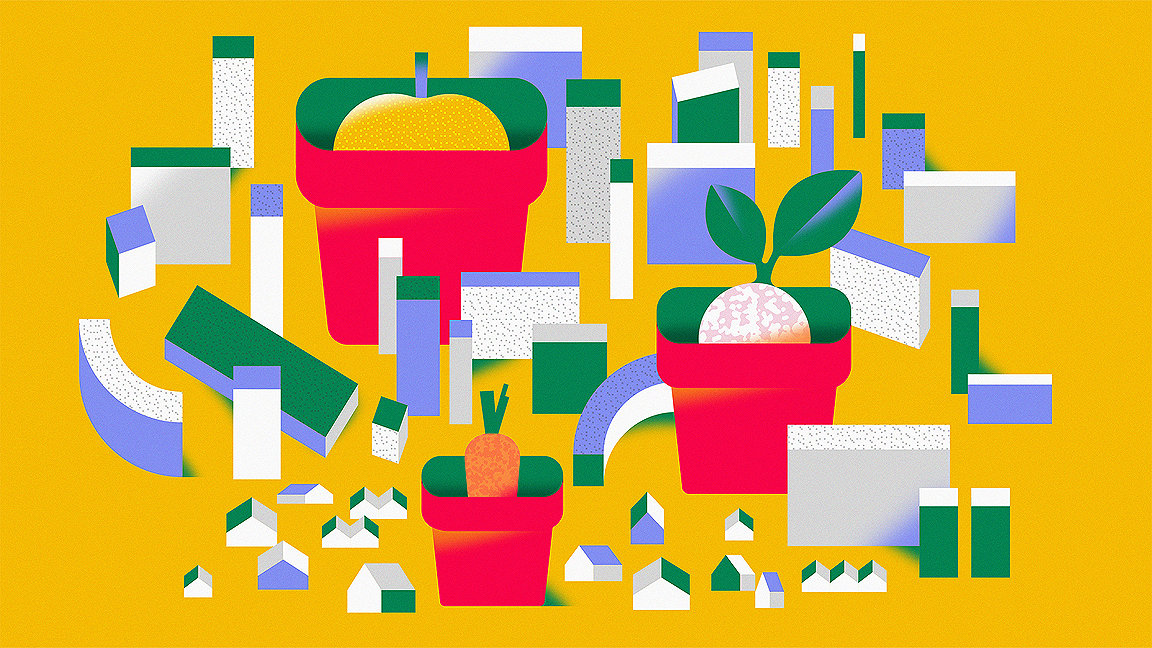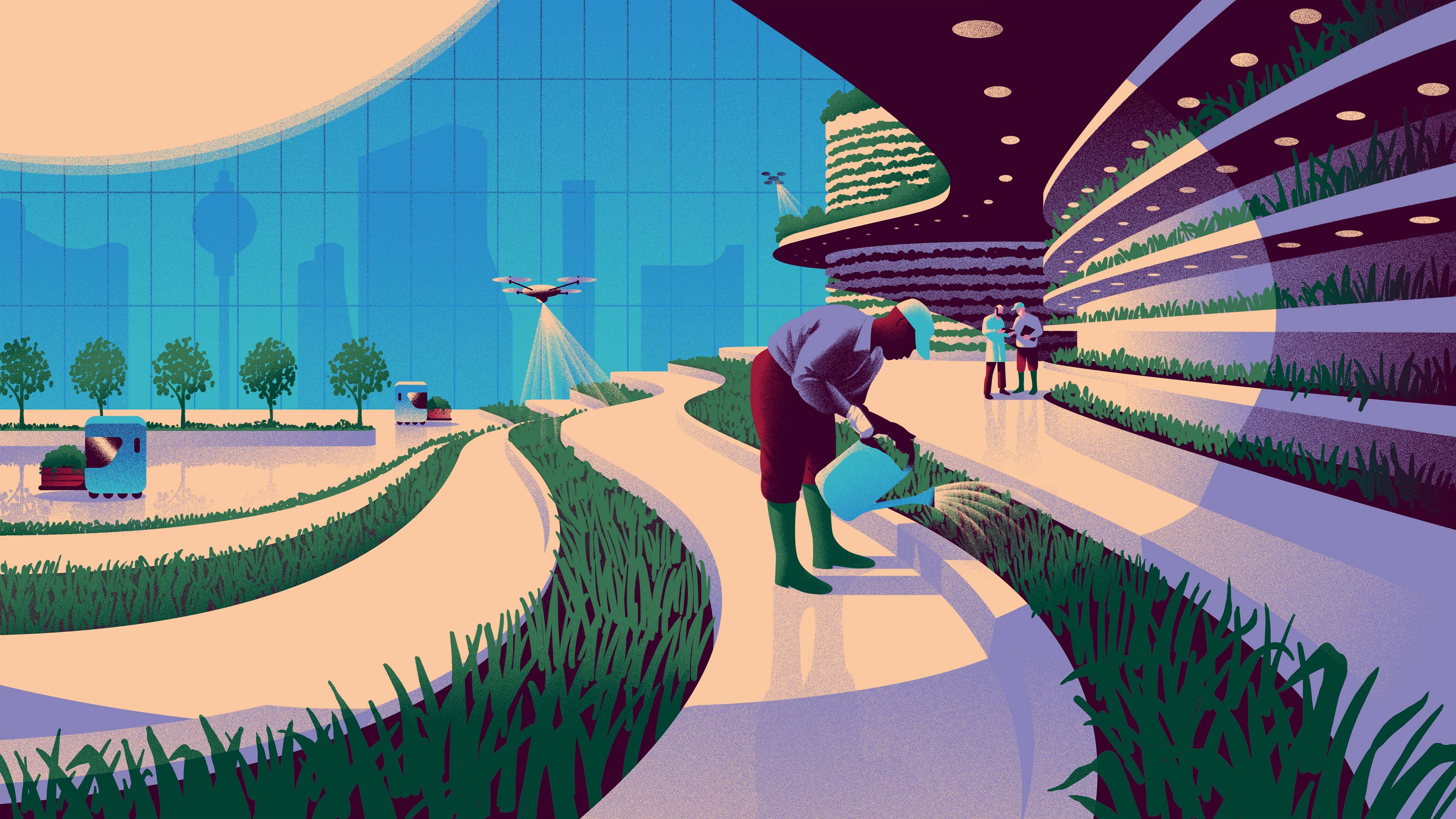
Illustrations by Giacomo Bagnara
Between 1649 and 1650, amid the English Civil War, a short-lived group called the Diggers had a dream that everyone should be able to plant and grow vegetables on common land.
This modest socialist ambition was soon crushed by wealthy land owners – the Diggers were arrested for trespassing and denounced as “royalists, atheists, libertines and polygamists”. Their homes were set on fire, their tools destroyed, and co-founder Gerrard Winstanley was threatened with death.
Happily, nearly 400 years later, the idea of turning unused plots of land into communal vegetable gardens is looked upon more favourably. Which is why organisations such as the Edible Cities Network (ECN) have flourished and implemented a range of sustainable food production methods in 150 cities around the world, from rooftop farms to urban beekeeping.
Residents can pick fruit and vegetables for free, be part of making cities healthier, greener and more liveable, improve urban drainage and help foster a greater sense of community. It’s a project funded by the European Commission, who awarded it €12m in 2018 to help it scale up and work in tandem with other ecological projects.
In Andernach, Germany, formerly overgrown areas of the town’s castle have been converted to orchards and vegetable patches. In Oslo, Norway, part of historic Linderud Manor is now a community garden. And in Carthage, Tunisia, early work is under way to identify unused land that can become productive farms and gardens. These are just three examples of places that are following the ECN framework to spread the benefits of communal gardening.
“We have many different groups involved in the project, including NGOs, entrepreneurs, researchers and start-ups that are working in this field,” says Dr Ina Säumel, principal investigator for Edible Cities Network.
“Our overall aim is to tackle ecological, economic and social challenges. We try to implement co-creation solutions, meaning there isn’t an expert that tells the others how to work. We work with the community and use knowledge learned from other projects.”
Säumel defines ECN initiatives as ones which often upgrade existing green or blue infrastructure in cities to make it edible. If a building has a rooftop garden, can it grow vegetables too? Can a system for dealing with stormwater runoff be adapted to provide water for a vegetable patch?
“There is also mushroom farming, insect farming and high-tech solutions that are not so common in the community garden world,” Säumel adds.
At a time of increased calls for city planners and property developers to consider biodiversity and the wellbeing benefits associated with outdoor spaces, local and national authorities are often eager participants in the ECN. But that doesn’t mean things happen overnight. “There can be a lot of rules and bureaucratic issues,” says Säumel.
“An initiative like this can appear and have success quickly, but then the sustainability on a longer run is complicated. You might need to change rules, laws or policies. And this takes a lot of time. Another big problem is the way administrations function. Someone deals with water, another person with soil, another person with green spaces. But we have ways to work with systems that can be quite resistant to change at times.”
Guerrilla gardening
One man who has taken a different approach and decided against working with an array of local authorities and their administrative nuances is Ron Finley, aka the ‘Gangsta Gardener’. Finley is based in Los Angeles and is an advocate for people picking up a shovel and growing their own food.
“As far as me working with organisations, no, that’s not the job I want,” says Finley. “I tell people to grow your own sh*t. I can show you how it works and help you but don’t expect me to come and maintain it for you. I’ll help you but I’m not the help.”

The passion with which Finley speaks highlights how important and deeply personal an issue this has become to him over the years. He’s become a crusader for community gardening and its wellbeing benefits, including the obvious health advantages of eating fresh food you’ve grown yourself. “I know what’s in my soil and I grew that food in my soil,” he says. “This stuff in the supermarket came from who the hell knows where.”

“Urban planning should work for people, let’s start there. People should be healthy” Ron Finley, The Ron Finley Project
Finley says he got tired of applying for grants for The Ron Finley Project and hearing that he “nearly got it, maybe next time”. Instead, he decided to affect change the way he wanted, “not the way they think it should be changed”.
“The biggest challenge is the whole system works perfectly for ‘them’,” says Finley. “It doesn’t work for us. And it should work for us. What happened to ‘we the people, for the people, by the people’? Urban planning should work for people, let’s start there. People should be healthy, but where I am, our air pollution is much worse than someone who’s living in Bel Air. Because of the traffic, because of where they put the freeways.
“I’ve talked to architecture classes and there’s one thing they’re not learning. I’ll ask the question ‘What are cities designed for?’ And they’ll look around like it’s obvious and someone will say ‘people’. And I say wrong, no, they’re not designed for people, they’re designed for commerce. If they were designed for people I would reach back here and there would be a pear in my hand, I wouldn’t have asthma, I wouldn’t have all kinds of particulates in my body from industrial processes.”
“That’s the first thing these students need to do: design cities for people and their health and happiness. And where you start with that is green spaces. You’re cleaning and filtering the air. If you want people happy, you put them in a beautiful space. Beauty doesn’t cost any more than ugly, it’s all about your intent.”
Biodiversity net gain regulations
Intent is a key word when it comes to new property developments. If ESG factors (environmental, social and governance) are high on the agenda and attract investors, then the provision of green space in residential and commercial developments becomes a much bigger part of the overall intent.
Andrew Little MRICS, a London-based partner at construction consultancy Baily Garner, says: “ESG credentials are also now a valued feature when leveraging finance from external sources and showing evidence of a sustainable and ethical investment. Alongside a clear asset management strategy, an ESG purpose also ensures assets avoid becoming stranded or obsolete.”
Additionally, in the UK from November, new legislation states that all building projects must improve biodiversity by a minimum of 10%. “Green space provision will ultimately be mandated by Environment Act [which contains the legislation],” says Little. “Developments that therefore have an attractive balance between built asset and green space will likely yield higher return-on-investment and be of greater demand.”

There are lots of options when it comes to increasing biodiversity, from protecting local wildlife habitats, to creating new ones (such as wildlife corridors) or providing green space in the form of private or shared gardens. “Community gardens are an excellent way to promote clean green space, enhance biodiversity and emphasise social inclusion and community interaction,” says Little.

“Community gardens are an excellent way to promote clean green space, enhance biodiversity and emphasise community interaction” Andrew Little MRICS, Baily Garner
Gardens create communities
While Finley, a guerrilla gardener in LA, inhabits a very different day-to-day world to Little, a chartered surveyor in London, they hold similar views on the power of communal gardening.
“Gardens create community, gardens create freedom,” says Finley. “Gardening creates relationships – if you grow together, you grow together.”
If the ECN continues to expand and work with towns and cities around the world, the number of community gardens will only increase. “I hope that in the future, Edible City solutions are part of the urban planner’s toolbox,” says Säumel.
Finley also has hopes for the way metropolitan areas are designed in future: “Cities need to be designed for people. That’s not just stacking them on top of each other, we need biomimicry where we mimic mother nature. And people need to start growing some of their own food.”
It’s worth noting that the ECN is not the only organisation working hard to convert as many city-dwellers as possible into enthusiastic gardeners. There are hundreds if not thousands of similarly green-thumbed groups all over the world on a mission that’s not so different to the Diggers of 400 years ago.

